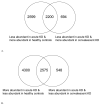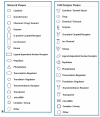Transcript abundance patterns in Kawasaki disease patients with intravenous immunoglobulin resistance
- PMID: 20600450
- PMCID: PMC2929310
- DOI: 10.1016/j.humimm.2010.06.008
Transcript abundance patterns in Kawasaki disease patients with intravenous immunoglobulin resistance
Abstract
Intravenous immunoglobulin (IVIG)-resistant Kawasaki disease (KD) patients comprise at least 20% of treated patients and are at high risk for coronary artery abnormalities. If identified early in the course of the disease, such patients may benefit from additional anti-inflammatory therapy. The aim of this study was to compare the transcript abundance between IVIG resistant and -responsive KD patients, to identify biomarkers that might differentiate between these two groups and to generate new targets for therapies in IVIG resistant KD patients. We compared the transcript abundance profiles of whole-blood RNA on Agilent arrays from acute and convalescent KD subjects and age-similar, healthy controls. KD subjects were stratified as IVIG resistant or -responsive based on response to initial IVIG therapy. Transcript abundance was higher for IL-1 pathway genes (IL-1 receptor, interleukin receptor associated kinase, p38 mitogen-activated protein kinase), and MMP-8. These findings point to candidate biomarkers that may predict IVIG resistance in acute KD patients. The results also underscore the importance of the IL-1 pathway as a mediator of inflammation in KD and suggest that IL-1 or its receptor may be reasonable targets for therapy, particularly for IVIG resistant patients.
Copyright 2010 American Society for Histocompatibility and Immunogenetics. Published by Elsevier Inc. All rights reserved.
Figures










References
-
- Abe J, Jibiki T, Noma S, Nakajima T, Saito H, Terai M. Gene expression profiling of the effect of high-dose intravenous Ig in patients with Kawasaki disease. J Immunol. 2005;174(9):5837. - PubMed
-
- Nomura I, Abe J, Noma S, Saito H, Gao B, Wheeler G, Leung DY. Adrenomedullin is highly expressed in blood monocytes associated with acute Kawasaki disease: a microarray gene expression study. Pediatr Res. 2005;57(1):49. - PubMed
-
- Ebihara T, Endo R, Kikuta H, Ishiguro N, Ma X, Shimazu M, Otoguro T, Kobayashi K. Differential gene expression of S100 protein family in leukocytes from patients with Kawasaki disease. Eur J Pediatr. 2005;164(7):427. - PubMed
-
- Furuno K, Takada H, Yamamoto K, Ikeda K, Ohno T, Khajoee V, Mizuno Y, Hara T. Tissue inhibitor of metalloproteinase 2 and coronary artery lesions in Kawasaki disease. J Pediatr. 2007;151(2):155. - PubMed
Publication types
MeSH terms
Substances
Grants and funding
LinkOut - more resources
Full Text Sources
Other Literature Sources
Medical
Molecular Biology Databases
Research Materials
Miscellaneous

